NUR 1202: Professional Identity Essay
VerifiedAdded on 2019/10/30
|6
|1733
|170
Essay
AI Summary
This essay, written for NUR 1202, explores professional identity in nursing. Part A analyzes Catlin Brassington's open letter, examining how it reflects professional nursing roles and responsibilities, including childbirth assistance, CPR, medication administration, wound care, and blood draws. The essay uses these examples to define professional identity and its ethical implications. Part B provides a personal reflection on the challenges and misconceptions surrounding the nursing profession, emphasizing the dedication, compassion, and perseverance required. The reflection highlights the need for nurses to actively communicate their professionalism to the public to counter negative perceptions and emphasizes the demanding nature of the profession, including long hours, workplace hazards, and potential for violence.
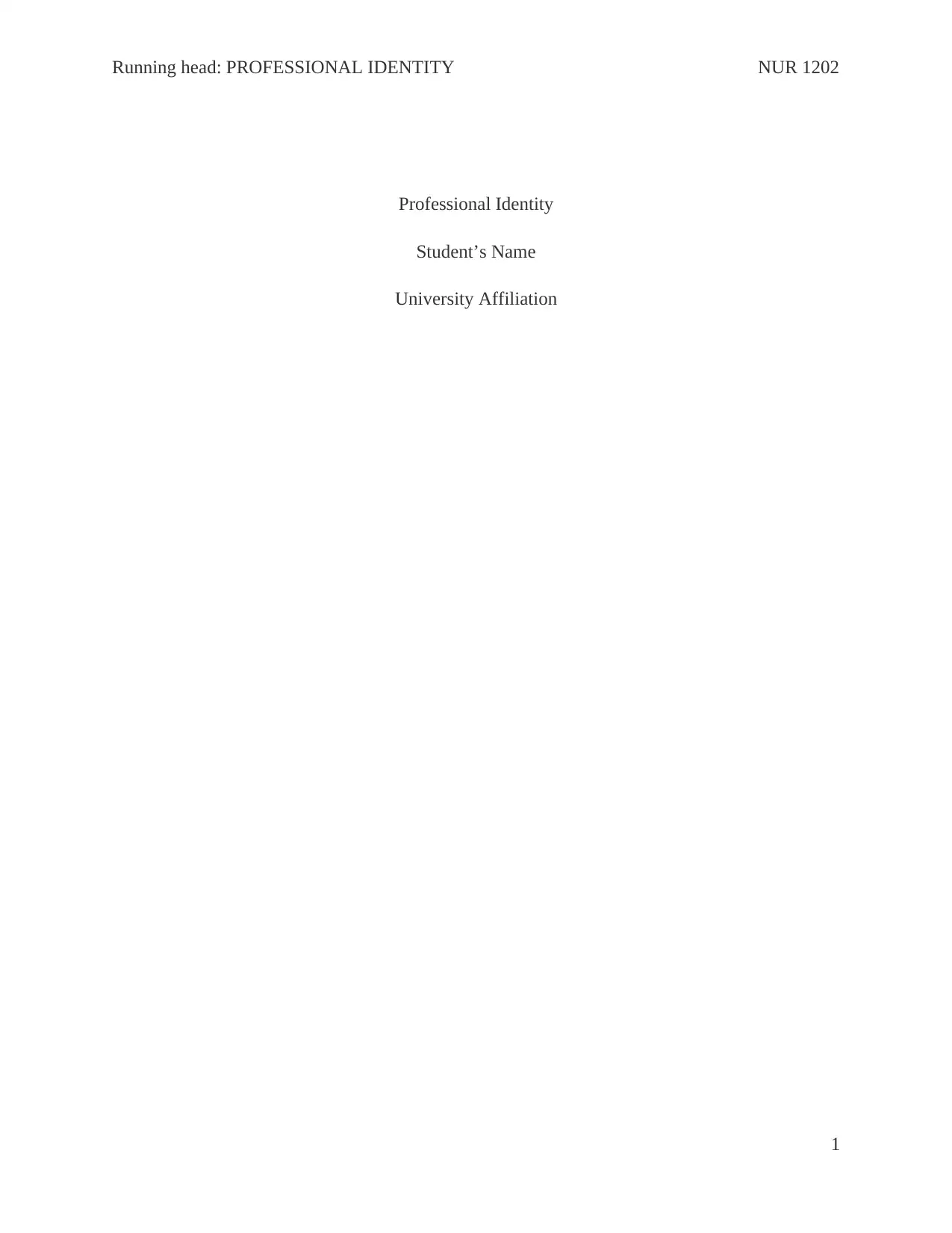
Running head: PROFESSIONAL IDENTITY NUR 1202
Professional Identity
Student’s Name
University Affiliation
1
Professional Identity
Student’s Name
University Affiliation
1
Paraphrase This Document
Need a fresh take? Get an instant paraphrase of this document with our AI Paraphraser
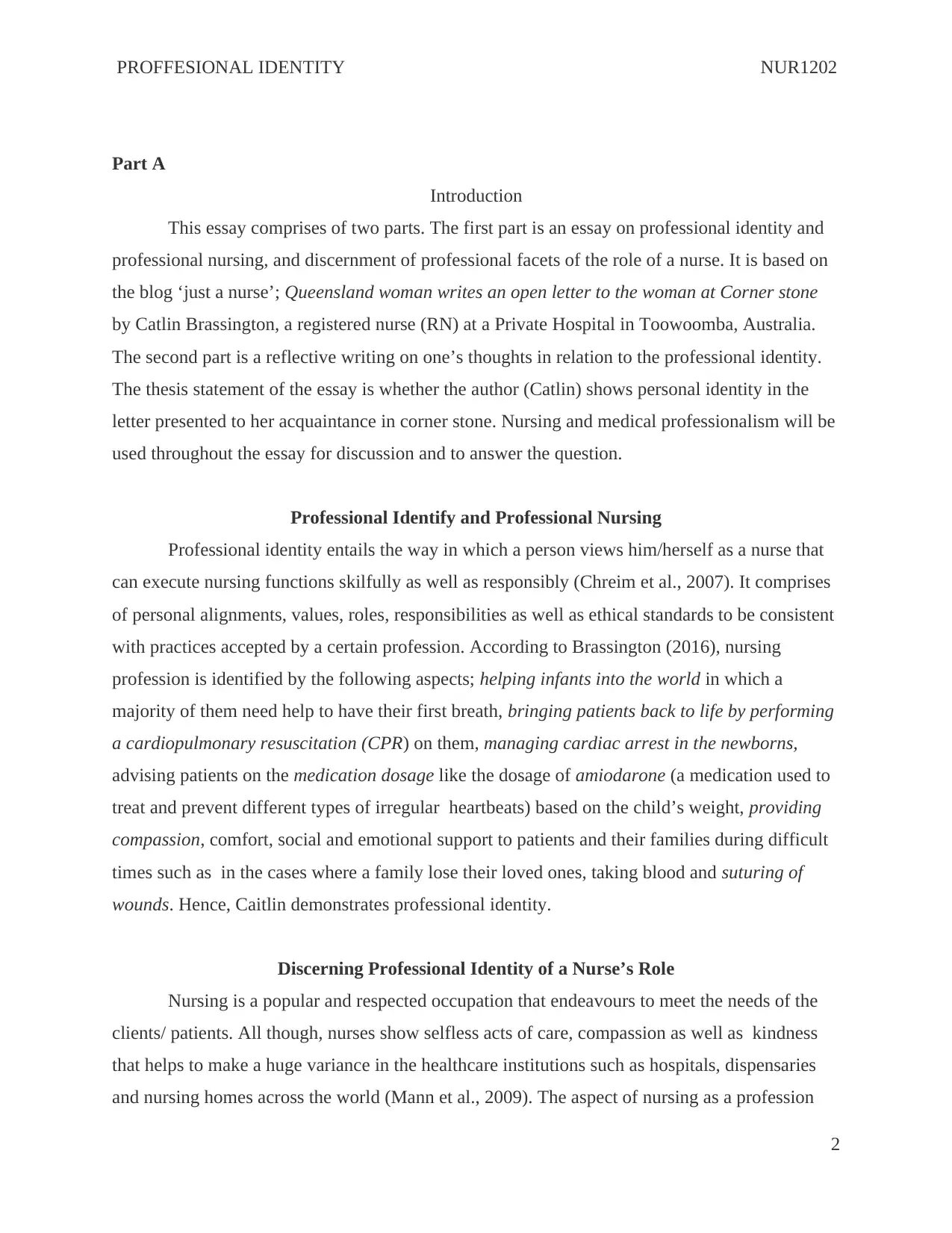
PROFFESIONAL IDENTITY NUR1202
Part A
Introduction
This essay comprises of two parts. The first part is an essay on professional identity and
professional nursing, and discernment of professional facets of the role of a nurse. It is based on
the blog ‘just a nurse’; Queensland woman writes an open letter to the woman at Corner stone
by Catlin Brassington, a registered nurse (RN) at a Private Hospital in Toowoomba, Australia.
The second part is a reflective writing on one’s thoughts in relation to the professional identity.
The thesis statement of the essay is whether the author (Catlin) shows personal identity in the
letter presented to her acquaintance in corner stone. Nursing and medical professionalism will be
used throughout the essay for discussion and to answer the question.
Professional Identify and Professional Nursing
Professional identity entails the way in which a person views him/herself as a nurse that
can execute nursing functions skilfully as well as responsibly (Chreim et al., 2007). It comprises
of personal alignments, values, roles, responsibilities as well as ethical standards to be consistent
with practices accepted by a certain profession. According to Brassington (2016), nursing
profession is identified by the following aspects; helping infants into the world in which a
majority of them need help to have their first breath, bringing patients back to life by performing
a cardiopulmonary resuscitation (CPR) on them, managing cardiac arrest in the newborns,
advising patients on the medication dosage like the dosage of amiodarone (a medication used to
treat and prevent different types of irregular heartbeats) based on the child’s weight, providing
compassion, comfort, social and emotional support to patients and their families during difficult
times such as in the cases where a family lose their loved ones, taking blood and suturing of
wounds. Hence, Caitlin demonstrates professional identity.
Discerning Professional Identity of a Nurse’s Role
Nursing is a popular and respected occupation that endeavours to meet the needs of the
clients/ patients. All though, nurses show selfless acts of care, compassion as well as kindness
that helps to make a huge variance in the healthcare institutions such as hospitals, dispensaries
and nursing homes across the world (Mann et al., 2009). The aspect of nursing as a profession
2
Part A
Introduction
This essay comprises of two parts. The first part is an essay on professional identity and
professional nursing, and discernment of professional facets of the role of a nurse. It is based on
the blog ‘just a nurse’; Queensland woman writes an open letter to the woman at Corner stone
by Catlin Brassington, a registered nurse (RN) at a Private Hospital in Toowoomba, Australia.
The second part is a reflective writing on one’s thoughts in relation to the professional identity.
The thesis statement of the essay is whether the author (Catlin) shows personal identity in the
letter presented to her acquaintance in corner stone. Nursing and medical professionalism will be
used throughout the essay for discussion and to answer the question.
Professional Identify and Professional Nursing
Professional identity entails the way in which a person views him/herself as a nurse that
can execute nursing functions skilfully as well as responsibly (Chreim et al., 2007). It comprises
of personal alignments, values, roles, responsibilities as well as ethical standards to be consistent
with practices accepted by a certain profession. According to Brassington (2016), nursing
profession is identified by the following aspects; helping infants into the world in which a
majority of them need help to have their first breath, bringing patients back to life by performing
a cardiopulmonary resuscitation (CPR) on them, managing cardiac arrest in the newborns,
advising patients on the medication dosage like the dosage of amiodarone (a medication used to
treat and prevent different types of irregular heartbeats) based on the child’s weight, providing
compassion, comfort, social and emotional support to patients and their families during difficult
times such as in the cases where a family lose their loved ones, taking blood and suturing of
wounds. Hence, Caitlin demonstrates professional identity.
Discerning Professional Identity of a Nurse’s Role
Nursing is a popular and respected occupation that endeavours to meet the needs of the
clients/ patients. All though, nurses show selfless acts of care, compassion as well as kindness
that helps to make a huge variance in the healthcare institutions such as hospitals, dispensaries
and nursing homes across the world (Mann et al., 2009). The aspect of nursing as a profession
2
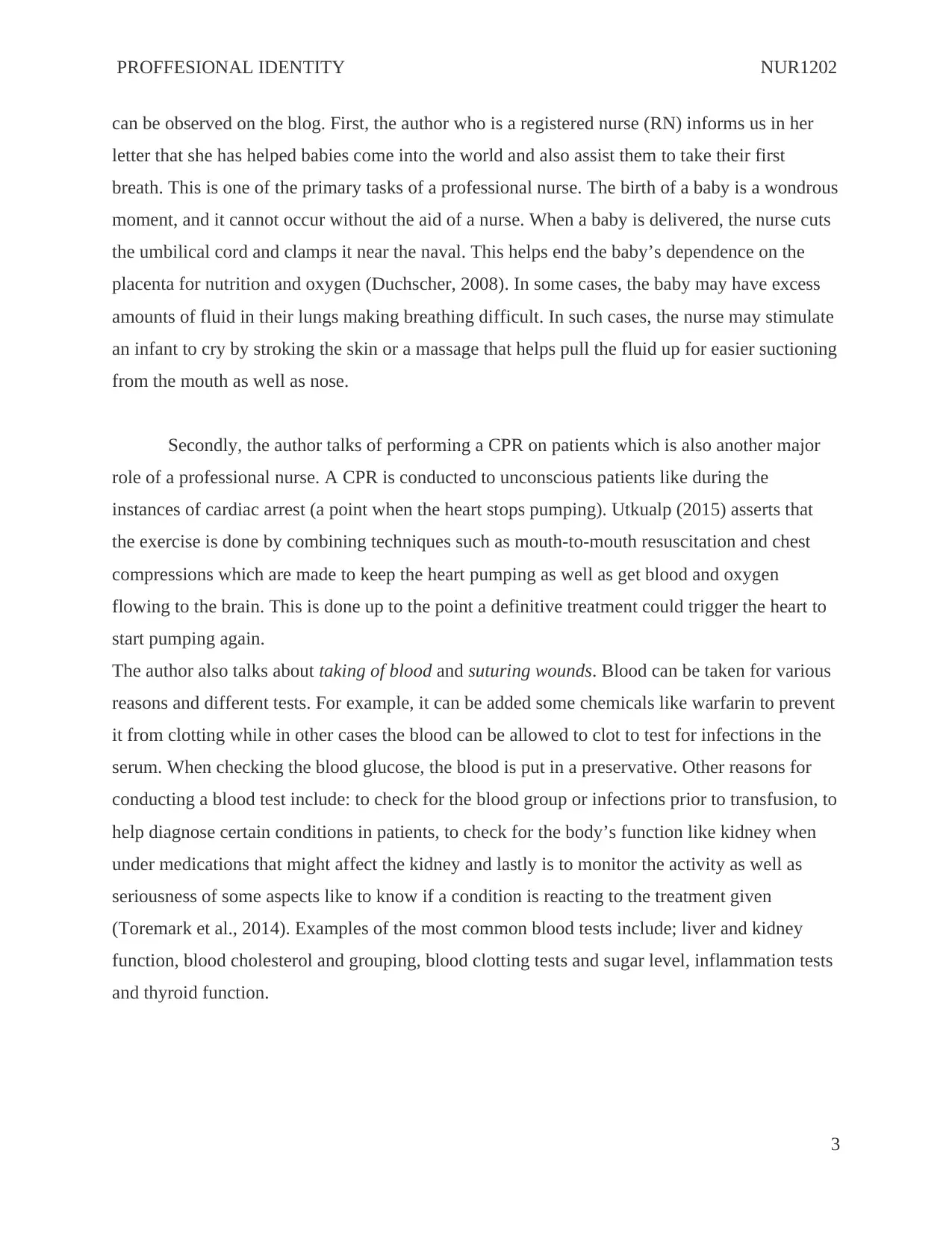
PROFFESIONAL IDENTITY NUR1202
can be observed on the blog. First, the author who is a registered nurse (RN) informs us in her
letter that she has helped babies come into the world and also assist them to take their first
breath. This is one of the primary tasks of a professional nurse. The birth of a baby is a wondrous
moment, and it cannot occur without the aid of a nurse. When a baby is delivered, the nurse cuts
the umbilical cord and clamps it near the naval. This helps end the baby’s dependence on the
placenta for nutrition and oxygen (Duchscher, 2008). In some cases, the baby may have excess
amounts of fluid in their lungs making breathing difficult. In such cases, the nurse may stimulate
an infant to cry by stroking the skin or a massage that helps pull the fluid up for easier suctioning
from the mouth as well as nose.
Secondly, the author talks of performing a CPR on patients which is also another major
role of a professional nurse. A CPR is conducted to unconscious patients like during the
instances of cardiac arrest (a point when the heart stops pumping). Utkualp (2015) asserts that
the exercise is done by combining techniques such as mouth-to-mouth resuscitation and chest
compressions which are made to keep the heart pumping as well as get blood and oxygen
flowing to the brain. This is done up to the point a definitive treatment could trigger the heart to
start pumping again.
The author also talks about taking of blood and suturing wounds. Blood can be taken for various
reasons and different tests. For example, it can be added some chemicals like warfarin to prevent
it from clotting while in other cases the blood can be allowed to clot to test for infections in the
serum. When checking the blood glucose, the blood is put in a preservative. Other reasons for
conducting a blood test include: to check for the blood group or infections prior to transfusion, to
help diagnose certain conditions in patients, to check for the body’s function like kidney when
under medications that might affect the kidney and lastly is to monitor the activity as well as
seriousness of some aspects like to know if a condition is reacting to the treatment given
(Toremark et al., 2014). Examples of the most common blood tests include; liver and kidney
function, blood cholesterol and grouping, blood clotting tests and sugar level, inflammation tests
and thyroid function.
3
can be observed on the blog. First, the author who is a registered nurse (RN) informs us in her
letter that she has helped babies come into the world and also assist them to take their first
breath. This is one of the primary tasks of a professional nurse. The birth of a baby is a wondrous
moment, and it cannot occur without the aid of a nurse. When a baby is delivered, the nurse cuts
the umbilical cord and clamps it near the naval. This helps end the baby’s dependence on the
placenta for nutrition and oxygen (Duchscher, 2008). In some cases, the baby may have excess
amounts of fluid in their lungs making breathing difficult. In such cases, the nurse may stimulate
an infant to cry by stroking the skin or a massage that helps pull the fluid up for easier suctioning
from the mouth as well as nose.
Secondly, the author talks of performing a CPR on patients which is also another major
role of a professional nurse. A CPR is conducted to unconscious patients like during the
instances of cardiac arrest (a point when the heart stops pumping). Utkualp (2015) asserts that
the exercise is done by combining techniques such as mouth-to-mouth resuscitation and chest
compressions which are made to keep the heart pumping as well as get blood and oxygen
flowing to the brain. This is done up to the point a definitive treatment could trigger the heart to
start pumping again.
The author also talks about taking of blood and suturing wounds. Blood can be taken for various
reasons and different tests. For example, it can be added some chemicals like warfarin to prevent
it from clotting while in other cases the blood can be allowed to clot to test for infections in the
serum. When checking the blood glucose, the blood is put in a preservative. Other reasons for
conducting a blood test include: to check for the blood group or infections prior to transfusion, to
help diagnose certain conditions in patients, to check for the body’s function like kidney when
under medications that might affect the kidney and lastly is to monitor the activity as well as
seriousness of some aspects like to know if a condition is reacting to the treatment given
(Toremark et al., 2014). Examples of the most common blood tests include; liver and kidney
function, blood cholesterol and grouping, blood clotting tests and sugar level, inflammation tests
and thyroid function.
3
⊘ This is a preview!⊘
Do you want full access?
Subscribe today to unlock all pages.

Trusted by 1+ million students worldwide
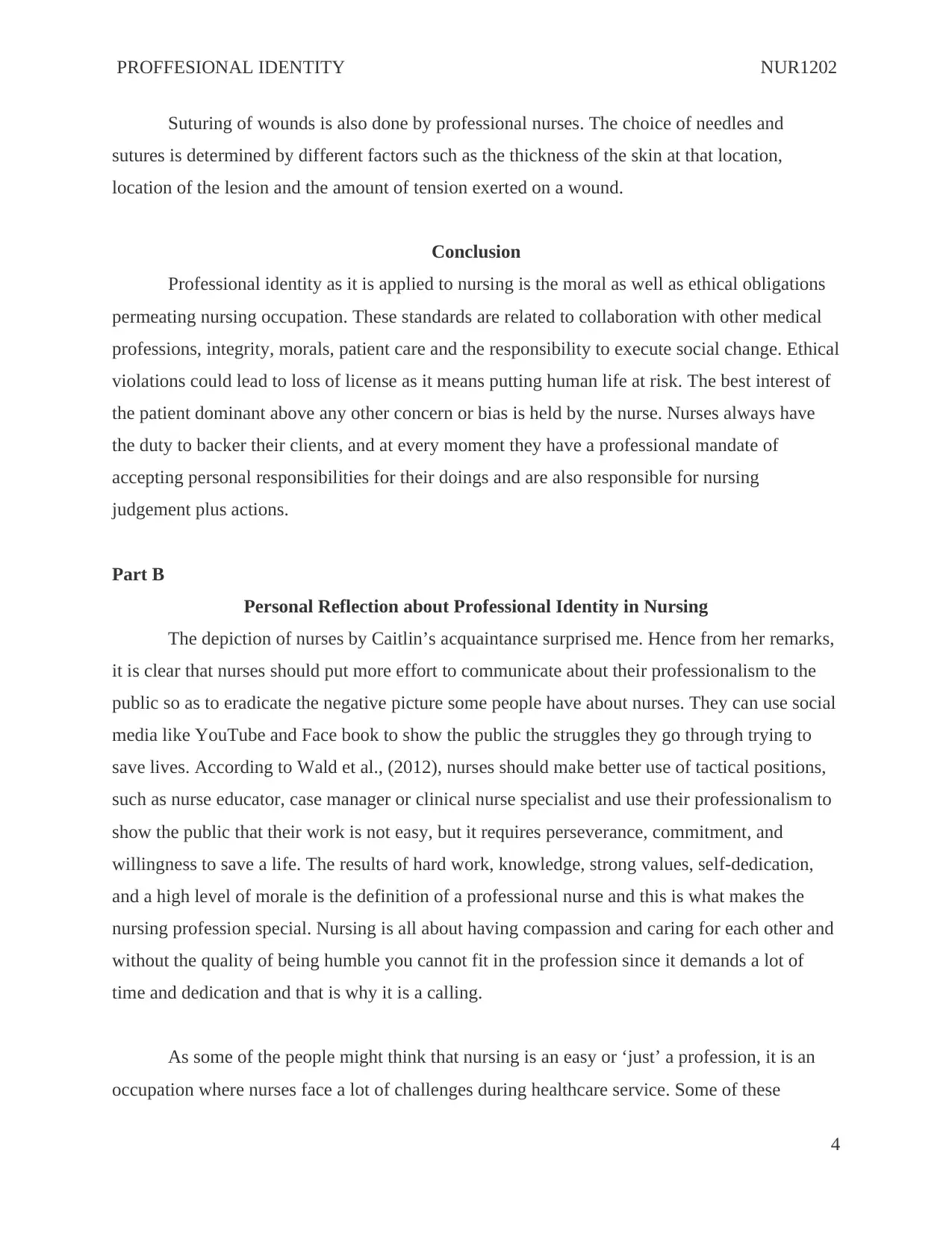
PROFFESIONAL IDENTITY NUR1202
Suturing of wounds is also done by professional nurses. The choice of needles and
sutures is determined by different factors such as the thickness of the skin at that location,
location of the lesion and the amount of tension exerted on a wound.
Conclusion
Professional identity as it is applied to nursing is the moral as well as ethical obligations
permeating nursing occupation. These standards are related to collaboration with other medical
professions, integrity, morals, patient care and the responsibility to execute social change. Ethical
violations could lead to loss of license as it means putting human life at risk. The best interest of
the patient dominant above any other concern or bias is held by the nurse. Nurses always have
the duty to backer their clients, and at every moment they have a professional mandate of
accepting personal responsibilities for their doings and are also responsible for nursing
judgement plus actions.
Part B
Personal Reflection about Professional Identity in Nursing
The depiction of nurses by Caitlin’s acquaintance surprised me. Hence from her remarks,
it is clear that nurses should put more effort to communicate about their professionalism to the
public so as to eradicate the negative picture some people have about nurses. They can use social
media like YouTube and Face book to show the public the struggles they go through trying to
save lives. According to Wald et al., (2012), nurses should make better use of tactical positions,
such as nurse educator, case manager or clinical nurse specialist and use their professionalism to
show the public that their work is not easy, but it requires perseverance, commitment, and
willingness to save a life. The results of hard work, knowledge, strong values, self-dedication,
and a high level of morale is the definition of a professional nurse and this is what makes the
nursing profession special. Nursing is all about having compassion and caring for each other and
without the quality of being humble you cannot fit in the profession since it demands a lot of
time and dedication and that is why it is a calling.
As some of the people might think that nursing is an easy or ‘just’ a profession, it is an
occupation where nurses face a lot of challenges during healthcare service. Some of these
4
Suturing of wounds is also done by professional nurses. The choice of needles and
sutures is determined by different factors such as the thickness of the skin at that location,
location of the lesion and the amount of tension exerted on a wound.
Conclusion
Professional identity as it is applied to nursing is the moral as well as ethical obligations
permeating nursing occupation. These standards are related to collaboration with other medical
professions, integrity, morals, patient care and the responsibility to execute social change. Ethical
violations could lead to loss of license as it means putting human life at risk. The best interest of
the patient dominant above any other concern or bias is held by the nurse. Nurses always have
the duty to backer their clients, and at every moment they have a professional mandate of
accepting personal responsibilities for their doings and are also responsible for nursing
judgement plus actions.
Part B
Personal Reflection about Professional Identity in Nursing
The depiction of nurses by Caitlin’s acquaintance surprised me. Hence from her remarks,
it is clear that nurses should put more effort to communicate about their professionalism to the
public so as to eradicate the negative picture some people have about nurses. They can use social
media like YouTube and Face book to show the public the struggles they go through trying to
save lives. According to Wald et al., (2012), nurses should make better use of tactical positions,
such as nurse educator, case manager or clinical nurse specialist and use their professionalism to
show the public that their work is not easy, but it requires perseverance, commitment, and
willingness to save a life. The results of hard work, knowledge, strong values, self-dedication,
and a high level of morale is the definition of a professional nurse and this is what makes the
nursing profession special. Nursing is all about having compassion and caring for each other and
without the quality of being humble you cannot fit in the profession since it demands a lot of
time and dedication and that is why it is a calling.
As some of the people might think that nursing is an easy or ‘just’ a profession, it is an
occupation where nurses face a lot of challenges during healthcare service. Some of these
4
Paraphrase This Document
Need a fresh take? Get an instant paraphrase of this document with our AI Paraphraser
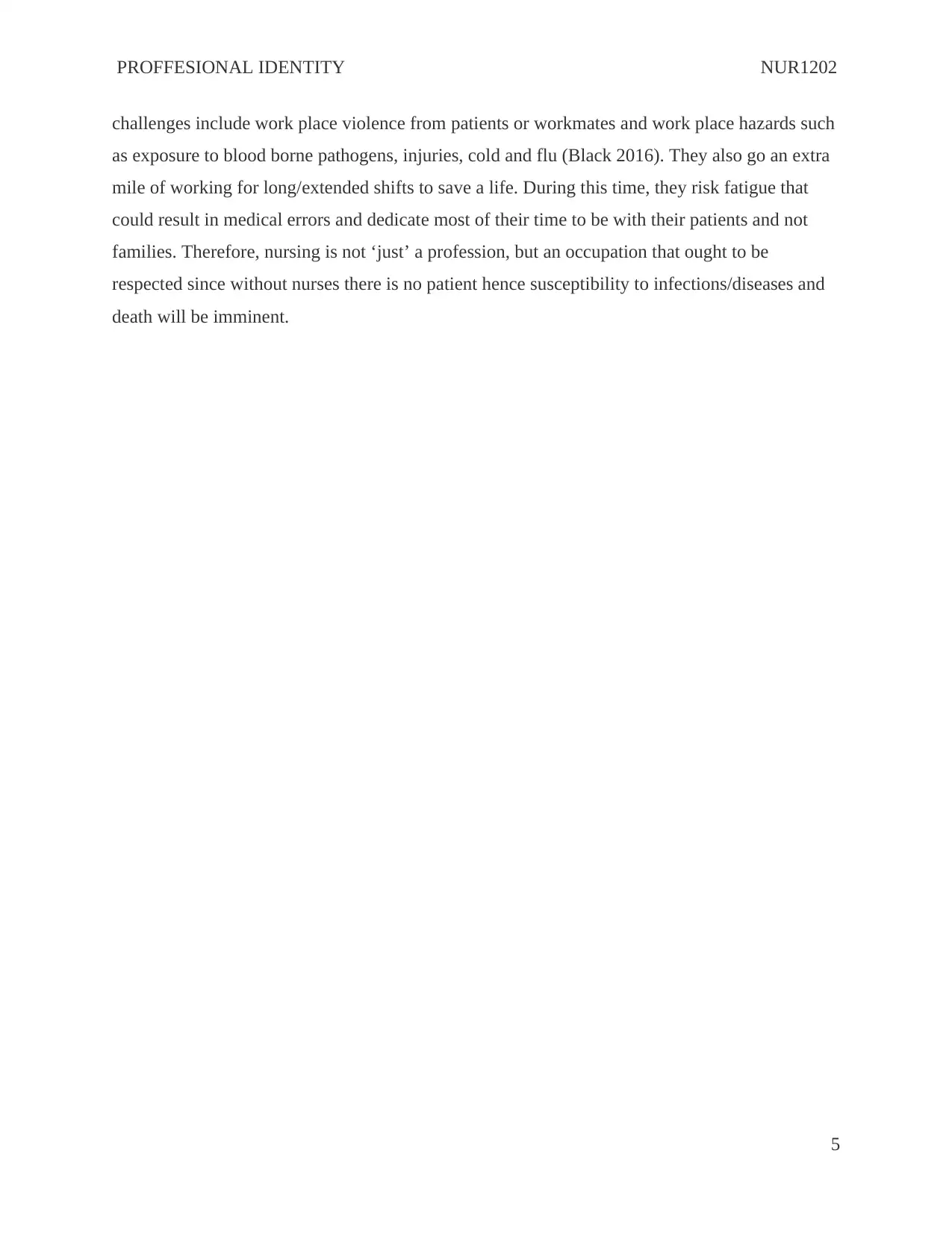
PROFFESIONAL IDENTITY NUR1202
challenges include work place violence from patients or workmates and work place hazards such
as exposure to blood borne pathogens, injuries, cold and flu (Black 2016). They also go an extra
mile of working for long/extended shifts to save a life. During this time, they risk fatigue that
could result in medical errors and dedicate most of their time to be with their patients and not
families. Therefore, nursing is not ‘just’ a profession, but an occupation that ought to be
respected since without nurses there is no patient hence susceptibility to infections/diseases and
death will be imminent.
5
challenges include work place violence from patients or workmates and work place hazards such
as exposure to blood borne pathogens, injuries, cold and flu (Black 2016). They also go an extra
mile of working for long/extended shifts to save a life. During this time, they risk fatigue that
could result in medical errors and dedicate most of their time to be with their patients and not
families. Therefore, nursing is not ‘just’ a profession, but an occupation that ought to be
respected since without nurses there is no patient hence susceptibility to infections/diseases and
death will be imminent.
5
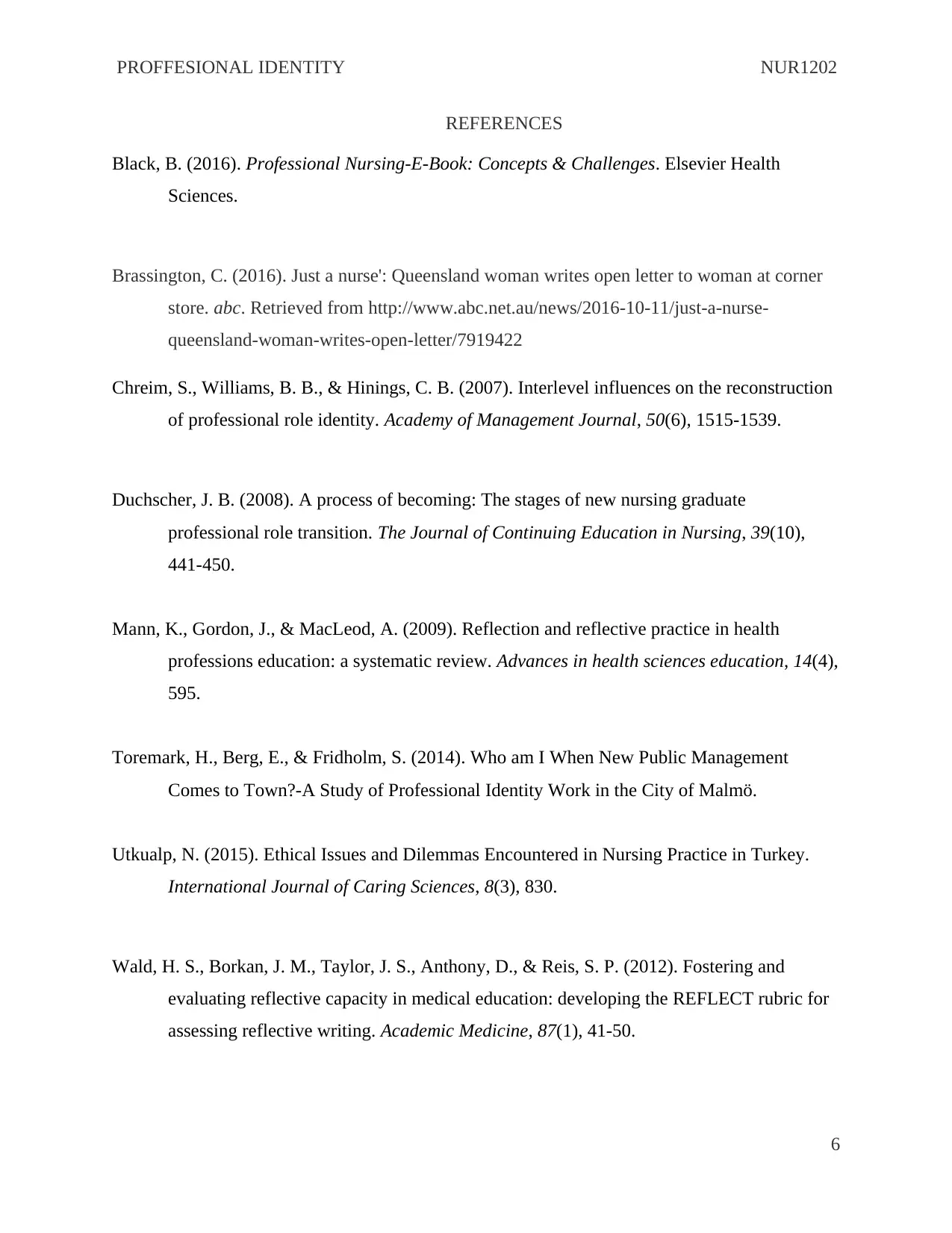
PROFFESIONAL IDENTITY NUR1202
REFERENCES
Black, B. (2016). Professional Nursing-E-Book: Concepts & Challenges. Elsevier Health
Sciences.
Brassington, C. (2016). Just a nurse': Queensland woman writes open letter to woman at corner
store. abc. Retrieved from http://www.abc.net.au/news/2016-10-11/just-a-nurse-
queensland-woman-writes-open-letter/7919422
Chreim, S., Williams, B. B., & Hinings, C. B. (2007). Interlevel influences on the reconstruction
of professional role identity. Academy of Management Journal, 50(6), 1515-1539.
Duchscher, J. B. (2008). A process of becoming: The stages of new nursing graduate
professional role transition. The Journal of Continuing Education in Nursing, 39(10),
441-450.
Mann, K., Gordon, J., & MacLeod, A. (2009). Reflection and reflective practice in health
professions education: a systematic review. Advances in health sciences education, 14(4),
595.
Toremark, H., Berg, E., & Fridholm, S. (2014). Who am I When New Public Management
Comes to Town?-A Study of Professional Identity Work in the City of Malmö.
Utkualp, N. (2015). Ethical Issues and Dilemmas Encountered in Nursing Practice in Turkey.
International Journal of Caring Sciences, 8(3), 830.
Wald, H. S., Borkan, J. M., Taylor, J. S., Anthony, D., & Reis, S. P. (2012). Fostering and
evaluating reflective capacity in medical education: developing the REFLECT rubric for
assessing reflective writing. Academic Medicine, 87(1), 41-50.
6
REFERENCES
Black, B. (2016). Professional Nursing-E-Book: Concepts & Challenges. Elsevier Health
Sciences.
Brassington, C. (2016). Just a nurse': Queensland woman writes open letter to woman at corner
store. abc. Retrieved from http://www.abc.net.au/news/2016-10-11/just-a-nurse-
queensland-woman-writes-open-letter/7919422
Chreim, S., Williams, B. B., & Hinings, C. B. (2007). Interlevel influences on the reconstruction
of professional role identity. Academy of Management Journal, 50(6), 1515-1539.
Duchscher, J. B. (2008). A process of becoming: The stages of new nursing graduate
professional role transition. The Journal of Continuing Education in Nursing, 39(10),
441-450.
Mann, K., Gordon, J., & MacLeod, A. (2009). Reflection and reflective practice in health
professions education: a systematic review. Advances in health sciences education, 14(4),
595.
Toremark, H., Berg, E., & Fridholm, S. (2014). Who am I When New Public Management
Comes to Town?-A Study of Professional Identity Work in the City of Malmö.
Utkualp, N. (2015). Ethical Issues and Dilemmas Encountered in Nursing Practice in Turkey.
International Journal of Caring Sciences, 8(3), 830.
Wald, H. S., Borkan, J. M., Taylor, J. S., Anthony, D., & Reis, S. P. (2012). Fostering and
evaluating reflective capacity in medical education: developing the REFLECT rubric for
assessing reflective writing. Academic Medicine, 87(1), 41-50.
6
⊘ This is a preview!⊘
Do you want full access?
Subscribe today to unlock all pages.

Trusted by 1+ million students worldwide
1 out of 6
Your All-in-One AI-Powered Toolkit for Academic Success.
+13062052269
info@desklib.com
Available 24*7 on WhatsApp / Email
![[object Object]](/_next/static/media/star-bottom.7253800d.svg)
Unlock your academic potential
Copyright © 2020–2025 A2Z Services. All Rights Reserved. Developed and managed by ZUCOL.

